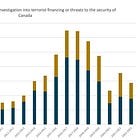Attack Patterns & Money Trails: Measuring Terrorist Financing
What do terrorist attacks cost in Canada, and what can that tell us about our counter-terrorism efforts?
Hello, Insight Monitor subscribers! Today, I’m sharing an article I’ve been working on for a long time (along with Brett, who does the research for this dataset). Today, I’m unveiling a new way of thinking about measuring terrorist financing and taking a first step towards quantifying what that looks like in Canada. If you find this interesting, please share it with a friend and help us grow our community. And a huge thank-you to the dozens of folks who have signed up for paid subscriptions over the last few weeks. The money we raise from these subscriptions goes directly towards supporting more data collection, new articles, and better policy!
Thanks for caring about illicit financing and global security,
~Jess
Researchers, policy analysts, and experts struggle to conceptualize terrorist financing. Many measures of terrorist financing are bandied about: for instance, in a recent opinion piece, the authors cited a 2006 Fraser Institute report that estimated “terror financing in Canada at $180 million annually” (as of 2004), information from FINTRAC, Canada’s financial intelligence unit.1 This is a highly flawed estimate that should not be used to describe anything about terrorist financing in Canada. Let me explain.
What the Fraser Institute fails to mention in their report is that this category is for both terrorist financing and threats to the security of Canada, such as foreign interference and espionage. They also fail to note that these disclosures might include multiple counts of the same transaction. For instance, the same transaction can be included in multiple terrorist financing disclosures to different recipients like CSIS or the RCMP. When this happens, the transaction amount will be counted twice. FINTRAC actually stopped providing value estimates for disclosures in later reports because they were too imprecise. Further, these transactions are not necessarily terrorist financing. They are disclosed because they could be relevant to a terrorist financing investigation. There is a lot of daylight between “is terrorist financing” and “could be relevant to an investigation”. You can read more about the FINTRAC thresholds and disclosures in these articles:2
We know that FINTRAC disclosures are not a good estimate of the level of terrorist financing in Canada, so what is? This is where things get tricky. Figuring out how much terrorist financing is happening (and the value of that financing) in a country at any given time is complicated. First, we have to outline the “universe” of terrorist financing or all the activities that have a financial component. This includes operational financing for attacks and organizational financing to support groups. It also includes the financing of disrupted attacks (plots), money raised for terrorist travel and propaganda, and funds that might transit the jurisdiction as part of obfuscation techniques.
Ultimately, I don’t know what the universe of terrorist financing in Canada is. No one does. But that does not mean that it’s unknowable! Some of these categories are tough to estimate (such as transit funds, for instance), but other categories can be quantified.
Today, we will do just that, and I will explain and explore operational attack financing in Canada. This can help us better understand the terrorist threat landscape in an empirically-sound way.








